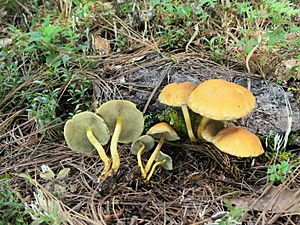Sulphur tuft facts for kids
Quick facts for kids Sulphur tuft |
|
|---|---|
 |
|
| Scientific classification | |
| Genus: |
Hypholoma
|
| Species: |
fasciculare
|
| Synonyms | |
|
|
| Hypholoma fasciculare | |
|---|---|
| Mycological characteristics | |
| gills on hymenium | |
| cap is convex | |
| hymenium is adnate | |
| stipe has a ring | |
| spore print is purple-brown | |
| ecology is saprotrophic | |
| edibility: poisonous | |
The sulphur tuft (scientific name: Hypholoma fasciculare) is a common woodland mushroom. You can often spot it when other mushrooms are hard to find. It is also known as the clustered woodlover.
This small fungus grows in large groups. It lives on tree stumps, dead roots, or rotting tree trunks. The sulphur tuft is saprotrophic. This means it gets its food from dead or decaying matter.
The sulphur tuft mushroom is very bitter and poisonous. If someone eats it, they can get sick. Symptoms might include vomiting, diarrhea, and even convulsions. The main harmful substance in it is called fasciculol E.
Contents
What's in a Name?
The scientific name fasciculare comes from a Latin word. It means 'in bundles' or 'clustered'. This describes how the mushroom grows in tight groups. In Japanese, this mushroom is called Nigakuritake. This name means "Bitter kuritake".
How to Spot a Sulphur Tuft
The top part of the mushroom, called the cap, is shaped like half a ball. It is usually about 2 to 6 centimeters (about 1 to 2.5 inches) wide. The cap is smooth and sulphur yellow. It has an orange-brown center and a lighter edge.
The gills underneath the cap are close together. They start yellow but turn a green color as they get older. This happens when the dark spores develop. The mushroom's flesh is yellow. When the spores drop, they leave a purple-brown spore print.
The stem, or stipe, is about 3 to 10 centimeters (about 1 to 4 inches) tall. It is 4 to 10 millimeters wide. The stem is light yellow and becomes orange-brown lower down. It often has a faint ring from the spores. The mushroom tastes very bitter, even if cooked. Remember, it is still poisonous!
Similar Mushrooms
Some mushrooms look a bit like the sulphur tuft. One is the edible Hypholoma capnoides. You can tell it apart because it does not have greenish-yellow gills. It also does not taste bitter. Another similar mushroom is H. sublateritium. This one has a reddish cap.
Where Sulphur Tufts Grow
Hypholoma fasciculare grows very well on dead wood. It can be found on both trees that lose their leaves (deciduous) and trees that keep their needles (coniferous). It is more common on deciduous wood. This is because that wood has less lignin, a tough substance.
This mushroom is common in northern Europe and North America. It has also been found in Iran and parts of Turkey. You can see it growing any time from spring to autumn.
Sulphur Tufts in Forests
Scientists have used Hypholoma fasciculare in experiments. They tried to use it to fight a common fungal disease in pine forests. This disease is caused by a fungus called Armillaria solidipes. The sulphur tuft can sometimes outcompete this harmful fungus.
Why Sulphur Tufts Are Poisonous
The sulphur tuft mushroom is poisonous because it contains special substances. These are called fasciculol E and fasciculol F. If a person eats these mushrooms, they might not feel sick right away. Symptoms can appear 5 to 10 hours later.
People who eat sulphur tufts may experience diarrhea, nausea, and vomiting. They might also feel very weak. Usually, these symptoms go away after a few days. It is very important never to eat this mushroom.
Gallery
See also
 In Spanish: Hifoloma de láminas verdes para niños
In Spanish: Hifoloma de láminas verdes para niños



